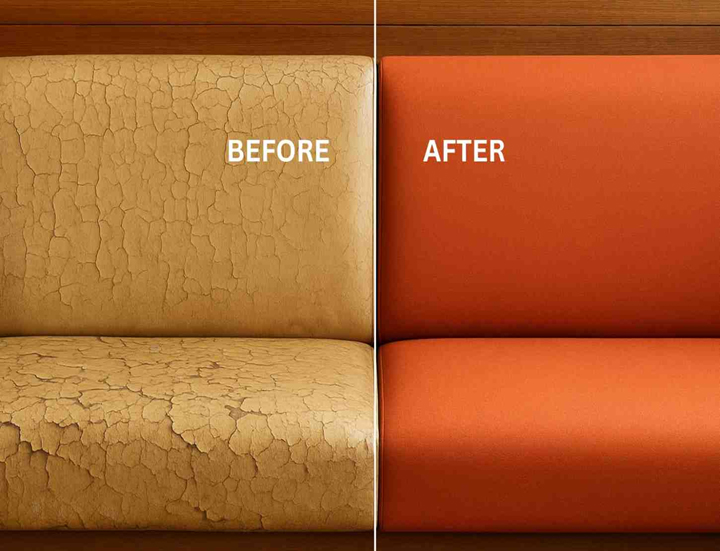What to Do If Your Restaurant Furniture Starts Peeling or Cracking

Restaurant furniture plays a crucial role in creating an inviting ambiance and offering comfort to your guests. However, over time, even the best-quality furniture can start showing signs of wear — such as peeling, cracking, or fading upholstery and finishes. These visible damages not only affect your restaurant’s appearance but can also leave a poor impression on customers.
In this blog, we’ll cover why restaurant furniture peels or cracks, how to fix it, preventive tips to avoid damage, and when to reupholster or replace your furniture to keep your dining space stylish and comfortable.
Common Reasons Why Restaurant Furniture Peels or Cracks
Before you start repairs, it’s essential to understand what’s causing the damage. Here are some common reasons:
- Exposure to Sunlight: Constant UV exposure can cause upholstery or wooden finishes to dry out and fade, leading to cracks and peeling.
- Low-Quality Material: Furniture made from low-grade leatherette, vinyl, or coatings tends to wear faster under heavy use.
- Improper Cleaning Products: Harsh chemicals or alcohol-based cleaners can strip finishes and weaken material surfaces.
- Frequent Usage: Daily wear and tear, especially in high-traffic dining areas, can gradually cause cracks or peeling.
- Humidity and Temperature Changes: Inconsistent indoor climates can cause wooden furniture and coatings to expand and contract, resulting in surface damage.
Steps to Fix Peeling or Cracking Furniture
1. Identify the Type of Material
Before attempting any repair, determine whether your furniture is made of leather, faux leather, wood, metal, or fabric. Each requires different repair methods.
2. Clean the Affected Area
Use a mild cleaner or a damp cloth to remove dust, grease, and dirt. Avoid soaking the surface — moisture can worsen cracks.
3. Repair Minor Peeling
For faux leather or vinyl:
- Use a vinyl repair kit to fill cracks.
- Apply color-matching leather paint for touch-ups.
- Seal with a protective coating for longer durability.
For wooden furniture:
- Sand the peeling area gently.
- Reapply a wood stain or varnish to restore shine and texture.
4. Address Deep Cracks
If cracks are deep or cover a large area, patching may not suffice.
In such cases:
- Replace the damaged upholstery panel.
- Consider reupholstering chairs or sofas with new, high-quality fabrics or leather.
This gives the furniture a brand-new look while extending its life.
5. Seek Professional Help
If your restaurant furniture shows widespread peeling or structural damage, professional furniture repair or reupholstery services are your best option. Experts can restore texture, color, and comfort efficiently, ensuring your restaurant maintains a premium image.
Preventive Tips to Avoid Peeling or Cracking
- Use Protective Covers: Especially for outdoor furniture, use covers when not in use to reduce sun and moisture damage.
- Regular Maintenance: Schedule periodic cleaning and conditioning to maintain leather or fabric integrity.
- Avoid Harsh Cleaners: Use only manufacturer-recommended cleaning agents.
- Control Indoor Climate: Maintain stable humidity and temperature to prevent wood expansion and cracking.
- Invest in Quality Materials: Durable upholstery fabrics and finishes are long-term investments that reduce frequent repairs.

When Should You Consider Reupholstering or Replacing?
Sometimes, damage goes beyond repair — for instance, when:
- Upholstery is torn or flaking across multiple areas.
- Foam padding has lost its shape or comfort.
- Frames are loose, warped, or rusted.

In these cases, reupholstering your restaurant furniture is a cost-effective solution that gives your interiors a refreshed look without the expense of full replacement.
If your furniture is outdated or doesn’t align with your new restaurant theme, replacement might be the best option to elevate your ambiance and attract customers.
How Topform Can Help You
At Topform Furnishing, we specialize in furniture upholstery, reviving worn-out restaurant furniture with expert craftsmanship. With over 30 years of experience, we deliver premium materials and elegant finishes in every project.
We:
- Repair peeling and cracked upholstery to give your furniture a fresh, polished look.
- Replace worn-out foam and padding to restore comfort and durability.
- Customize fabrics and colors to perfectly match your restaurant’s theme and décor.
- Deliver strong stitching and refined finishes for long-lasting results.
- Offer honest guidance on whether to reupholster or replace your furniture.
With our professional expertise, your restaurant furniture will remain stylish, comfortable, and built to last, creating a welcoming ambiance for your guests.
Frequently Asked Questions (FAQs)
Why is my restaurant furniture peeling so fast?
Peeling often occurs due to low-quality upholstery materials or excessive exposure to heat and sunlight. Regular cleaning with harsh chemicals can also weaken the surface over time.
Can I fix peeling furniture myself?
Yes, minor peeling or cracking can be repaired using vinyl or leather repair kits. However, for larger areas or structural issues, professional reupholstery is recommended.
How often should I maintain restaurant furniture?
Ideally, furniture should be cleaned weekly and professionally inspected every 6–12 months. Regular upkeep prevents minor damages from turning into costly repairs.
Should I replace or reupholster my furniture?
If the frame is sturdy and only the upholstery is damaged, reupholstery is more affordable and sustainable. But if the structure is weakened, it’s best to replace the furniture.
What materials last longest in restaurants?
For durability and easy maintenance, opt for genuine leather, high-quality vinyl, treated wood, or metal-framed furniture. These withstand frequent use and are easier to clean.